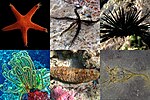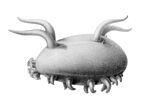Tube feet (technically podia) are small active tubular projections on the oral face of an echinoderm, such as the arms of a starfish, or the undersides...
4 KB (410 words) - 05:48, 3 November 2024
of red or orange, while others are blue, grey or brown. Starfish have tube feet operated by a hydraulic system and a mouth at the centre of the oral or...
105 KB (11,408 words) - 10:29, 1 November 2024
with the next-most-anterior genes expressed in the surrounding fringe of tube feet. Genes related to the beginning of the trunk are expressed at the ray...
85 KB (9,348 words) - 18:28, 2 November 2024
centimeters (31 cu in), and 25–30 cm (10–12 in) long. Most possess five rows of tube feet (called "podia"), but Apodida lacks these and moves by crawling; the podia...
60 KB (6,700 words) - 16:31, 20 September 2024
Strongylocentrotus droebachiensis (section Tube feet)
pentameric symmetry, which is visible in the five paired rows of podia (tube feet) that run from the anus to the mouth. The size is calculated as the diameter...
18 KB (2,475 words) - 07:27, 3 November 2024
10 cm (1 to 4 in) across. Sea urchins move slowly, crawling with their tube feet, and sometimes pushing themselves with their spines. They feed primarily...
80 KB (8,034 words) - 07:49, 2 November 2024
appearance. Both arms and pinnules have tube feet along the margins of the ambulacral grooves. The tube feet come in groups of three of different size;...
42 KB (4,509 words) - 08:03, 29 September 2024
A pitot tube (/ˈpiːtoʊ/ PEE-toh; also pitot probe) measures fluid flow velocity. It was invented by French engineer Henri Pitot in the early 18th century...
11 KB (1,230 words) - 19:17, 23 September 2024
known as sea pigs. Members of the Elpidiidae have particularly enlarged tube "feet" that have taken on a leg-like appearance, using water cavities within...
14 KB (1,524 words) - 13:01, 22 October 2024
canals connecting numerous tube feet. Echinoderms move by alternately contracting muscles that force water into the tube feet, causing them to extend and...
9 KB (1,279 words) - 15:50, 2 February 2024









